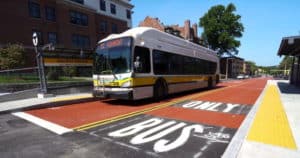
An MBTA bus drives through new bus-only lanes in Boston's Jamaica Plain neighborhood. Photo courtesy of the MBTA
Bus lanes the city of Boston installed on Huntington Avenue last fall are saving riders on two busy MBTA bus lines 125 hours a week and making the two lines significantly more reliable, the T said.
The lanes parallel the MBTA’s Green Line from Brigham Circle almost to Massachusetts Avenue.
The MBTA’s Route 39 and CT2 bus lines use the lanes and carried around 14,000 riders per day before the pandemic according to route profiles produced by the MBTA’s Better Bus Project, the most recent line-by-line data still publicly available.
The CT2 connects Kendall Square with Sullivan Square and Union Square to the north and Boston University and Longwood Medical Area with the T’s Ruggles subway, commuter rail and bus hub to the south. The 39 bus serves Jamaica Plain, connecting the neighborhood with the Forest Hills subway, commuter rail and bus station to the south with the Longwood Medical Area and Copley Square.
“This project shows how the MBTA can efficiently and effectively implement meaningful measures that improve bus service and reliability for thousands of transit riders in partnership with municipalities,” MBTA General Manager Phil Eng said in a statement. “I want to thank the T’s Bus Transformation staff for their dedicated efforts on this project, and BTD and the City for continuing to collaborate with us on bus lanes and improvements, which benefit so many.”
The T’s data report comes as Boston transportation officials are rolling out similar street upgrades along Washington and Cambridge streets in Brighton, to make the Route 57 bus that serves as the neighborhood’s main transportation artery faster and more reliable, and are investigating how to achieve the same goals for the Route 39 bus as it passes through Jamaica Plain along Centre Street.
“This project demonstrates the benefits of rebalancing our street space to prioritize transit,” Boston Chief of Streets Jascha Franklin-Hodge said in a statement provided by the T. “Dedicated bus lanes save bus riders time and are one of the most effective ways that the City can improve transit and make it a more convenient and reliable option for our residents.”
As T officials look to implement a sweeping modernization of the region’s bus network in the next few years, they’ll be relying more and more on municipal officials to cooperate to fulfill the new network’s promise. Bus lanes, whether full-time or rush hour-only, or shorter ones that let buses jump past cars backed up at traffic lights often require on-street parking spots to be displaced.






